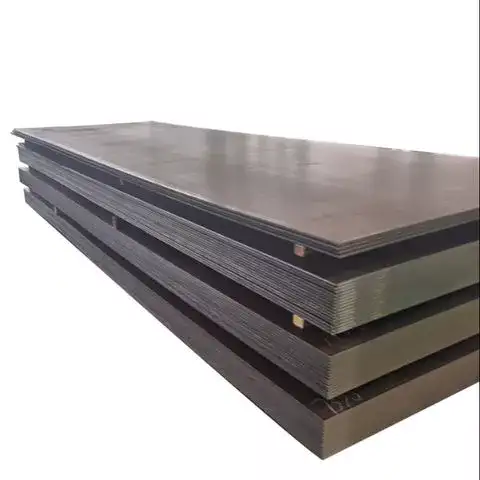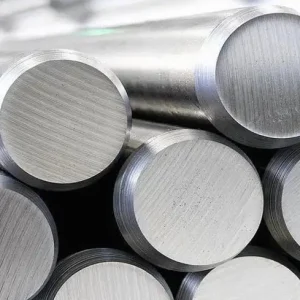AISI/SAE 1045 cold-rolled steel plate is a medium-carbon plate that combines higher strength and wear resistance than low-carbon steels with good machinability and predictable heat-treat response; it's an economical choice for shafts, gears, axles, machine parts, and structural components where moderate toughness and dimensional accuracy are required. For buyers seeking cost-effective supply and fast shipment, MWAlloys offers factory-direct 1045 cold-rolled plate from China with competitive EXW pricing, warehouse stock for quick dispatch, and standard mill test certificates.
What is 1045 cold-rolled steel?
AISI/SAE 1045 is a medium-carbon steel (nominal carbon ≈ 0.45%) commonly supplied in hot-rolled or cold-rolled conditions. When supplied as cold-rolled plate/sheet, the material benefits from improved surface finish, tighter thickness tolerances and better flatness compared with hot-rolled plate, while retaining the base chemistry and heat-treatability characteristic of 1045. Cold rolling slightly increases yield and tensile strengths (due to work hardening) in the as-rolled state and produces a smooth, mill-finished surface suitable for machining and finishing operations.
Why choose 1045 cold-rolled plate?
-
Balanced mechanical properties: higher strength than mild steels but easier to machine/heat-treat than alloy steels.
-
Good for medium-duty rotating parts (shafts, spindles), gears, studs, and forgings.
-
Cold rolling improves dimensional control for parts that require tight thickness and flatness.
-
Cost advantage when purchased direct from mill or factory stock — MWAlloys supplies 100% factory price and rapid delivery from China.
Chemical composition
Below is a standard composition window commonly cited for SAE/AISI 1045 (mill certificates should be requested for exact batch values):
| Element | Typical range (wt. %) |
|---|---|
| Carbon (C) | 0.42 – 0.50 |
| Manganese (Mn) | 0.60 – 0.90 |
| Silicon (Si) | ~0.10 – 0.35 (trace typical) |
| Phosphorus (P) | ≤ 0.040 |
| Sulfur (S) | ≤ 0.050 |
| Iron (Fe) | Balance (≈ 98.5–99.0%) |
(Interpretation: the ~0.45% C content gives 1045 substantially higher hardenability and strength than low-carbon steels while retaining reasonable machinability and weldability with preheat/controls.)
Mechanical & physical properties
The mechanical values depend on condition (cold-rolled, normalized, annealed, quenched & tempered). Below are commonly referenced ranges for 1045 in a typical supply condition:
| Property | Typical range (as-rolled / normalized) |
|---|---|
| Tensile strength (UTS) | 570 – 700 MPa |
| Yield strength (0.2% proof) | ≈ 300 – 450 MPa |
| Elongation in 50 mm | ~12 – 20 % |
| Brinell hardness (HB) | 170 – 210 HB (depends on heat treatment) |
| Density | 7.85 g/cm³ (typical steel) |
| Modulus of elasticity | ≈ 200 GPa |
Notes: heat treatment (normalizing, quench & temper) can raise strength and hardness considerably; annealing reduces hardness and improves machinability. Always check mill test certificate for supply condition.
1045 cold-rolled steel plate specifications
Manufacturers and sellers list plates in different sizes and tolerances. The table below shows a representative specification set that buyers commonly request.
| Parameter | Typical supply / recommended PO text |
|---|---|
| Grade | SAE/AISI 1045 (medium carbon) |
| Condition | Cold-rolled, pickled mill finish (or polished if requested) |
| Thickness range | 0.5 mm – 25 mm (commonly stocked 1.0–12.0 mm for cold-rolled sheet/plate; >12 mm often hot-rolled) |
| Width x Length | 1000×2000 mm, 1250×2500 mm, 1500×3000 mm, 2000×3000 mm (custom cut to size available) |
| Thickness tolerance | ±0.05 mm (thin gauges) to ±0.5 mm (thicker plates) — confirm mill spec |
| Flatness | Specified by customer (e.g., max warp 0.2%) |
| Surface | Mill cold-rolled finish, no coating unless ordered |
| Certification | Mill Test Certificate (EN10204 3.1 or equivalent) |
| Testing | Mechanical test report, chemical analysis, ultrasonic or RT on request |
(Important: cold-rolled plate thicker than ~12 mm is less common — for heavy plates buyers typically use hot-rolled 1045 and then machine or normalize.)
International equivalents and standards
1045 maps to common international grades. Use equivalents carefully — always confirm by chemical and mechanical requirements on the certificate.
| SAE/AISI | DIN/EN | JIS | China (GB) |
|---|---|---|---|
| 1045 | C45 / 1.0503 (EN 10083-2) | S45C | 45# (GB/T 699) |
EN 10083-2 provides technical delivery conditions for non-alloy steels; Chinese GB grades use the “45#” designation for similar chemistry.
Common uses of 1045 cold-rolled plate
Practical applications where 1045 cold-rolled plate is chosen:
-
Precision shafts, spindles and axles where dimensional control matters.
-
Gears, gear blanks, and sprockets (often normalized or quenched & tempered after rough machining).
-
Machine bases, bolsters, and structural parts requiring higher strength than mild steel.
-
Bushings, studs, and industrial fasteners (after heat treatment).
-
Forging blanks and partially machined components.
Example: a workshop may buy 1045 cold-rolled plate 12 mm thick for manufacturing short shafts that require close thickness tolerance and a fine surface prior to turning.
Sizes, thickness and weight
Use the steel weight formula: Weight (kg) = Area (m²) × thickness (mm) × 7.85 / 1000. For common sheet sizes, see the table (values per single sheet):
| Thickness (mm) | Sheet size (mm) | Area (m²) | Weight per sheet (kg) |
|---|---|---|---|
| 1.0 | 1000×2000 | 2.00 | 15.7 |
| 2.0 | 1000×2000 | 2.00 | 31.4 |
| 3.0 | 1250×2500 | 3.125 | 24.5 |
| 6.0 | 1500×3000 | 4.5 | 212.0 |
| 12.0 | 2000×3000 | 6.0 | 565.2 |
(Formula and density reference: standard steel density 7.85 g/cm³ — see Engineering Toolbox for calculation method.)
Cold-rolling effects, tolerances and manufacturing notes
-
Work hardening: cold rolling increases strength and hardness modestly; annealing may be specified if lower hardness and better formability are required.
-
Surface finish: cold-rolled surfaces are smoother and exhibit better edge definition than hot-rolled. This reduces finishing cost for machined components.
-
Dimensional control: cold rolling enables tighter thickness tolerance and improved flatness; critical for parts made with precision stamping or laser cutting.
-
Limitations: 1045 is a medium-carbon steel and can be more difficult to cold-form (deep drawing) than low-carbon steels. For forming operations, consider annealing before forming.
2025 price snapshot — USA / Europe / China
Steel prices fluctuate with mills, tariffs, steel product, and regional supply. The figures below are market snapshot estimates for 2025 and intended as starting points — always request a live quote.
| Region | Representative product | Approx. range (USD per metric ton) | Source / note |
|---|---|---|---|
| USA | Cold-rolled coil / plate (spot mid-2025) | $1,050 – $1,200 / MT | Industry reports (CRC spot ranges mid-2025). |
| Europe | Domestic steel plate (8–40mm) | €590 – €620 / MT (~$690 – $725) | Fastmarkets / regional assessment July-Aug 2025. |
| China | Cold-rolled medium-carbon (domestic quote) | $600 – $1,000 / MT (varies by mill, MOQ) | Marketplace listings & spot offers; China spot prices are typically lower but depend on grade, processing and domestic demand. |
Caveats: prices depend on product (coil vs plate), thickness, processing (cold-rolled, pickled, annealed), tariffs and transport. For export EXW factory pricing from China, MWAlloys can provide real-time quotes with certificate and delivery options.
Stock, lead times, inspection & traceability
MWAlloys supply features (typical offering for factory-direct buyers):
-
Stock: common sizes in 1045 cold-rolled sheet available in regional warehouses.
-
Certs: Mill Test Certificate (chemical + mechanical) — EN 10204 3.1 available on request.
-
Inspection: visual, dimensional, and NDT (UT/MT) available prior to shipment.
-
Lead time: stock orders ship within 3–10 working days; mill orders depend on production schedules (confirm with sales).
-
Logistics: factory EXW quoted; FOB and CIF available. MWAlloys emphasizes 100% factory price advantage and expedited handling for stocked items. (Ask for COA and photos pre-shipment.)
Fabrication notes: cutting, welding, forming and heat treatment
-
Cutting: laser, plasma and flame cutting are commonly used; small burrs after plasma may need finishing.
-
Welding: 1045 is moderate-carbon; direct welding without preheat can risk cracking — preheat and post-weld treatment usually recommended for thicker sections or critical parts. Low hydrogen consumables and 150–200°C preheat (depending on thickness) are common practice.
-
Forming: cold forming of 1045 is limited; for bends or deep draws, anneal before forming.
-
Heat treatment: annealing improves ductility and machinability; normalizing and quench & temper used to raise strength for gears/shafts. Always specify target hardness or mechanical properties if heat-treated.
How to specify 1045 cold-rolled plate in your purchase order
-
Material grade: AISI/SAE 1045 (or equivalent: C45 / 45#)
-
Condition: Cold-rolled, pickled / unpickled / polished as required
-
Thickness and tolerance (e.g., 3.0 ±0.05 mm)
-
Length × Width or cut-to-size details
-
Surface finish and edge (mill finish, deburred etc.)
-
Certification: Mill Test Certificate (EN 10204-3.1) required? (Yes/No)
-
Testing: UT or RT if required; hardness test points; mechanical test reports.
-
Packaging: wooden crate / standard export packaging / chemical-free packing.
-
Delivery term: EXW / FOB / CIF and incoterms date.
-
Quantity, part numbers and any heat treatment or additional processing.
FAQs
1. Is 1045 the same as C45 or 45#?
Essentially yes: SAE/AISI 1045 corresponds to DIN/EN C45 and China’s 45# grade, but always verify the mill certificate to confirm exact chemical and mechanical values.
2. What thicknesses are typically cold-rolled for 1045?
Cold-rolled stock is commonly supplied up to ~12 mm; for thicker plates, hot-rolled supply is more common. Confirm with supplier.
3. Can 1045 be case-hardened (surface hardened)?
1045 can be through-hardened and responds to induction or flame hardening; it does not case-harden as readily as low-carbon steels without special surface treatments. Specify process early.
4. Is 1045 weldable?
Weldable with precautions: preheat and controlled cooling are recommended to avoid cracking—especially for thicker sections.
5. What are typical mechanical strengths?
UTS typically 570–700 MPa; yield ≈ 300–450 MPa; HB ≈ 170–210 (varies by condition).
6. Does cold-rolling change composition?
No; cold-rolling changes microstructure (work-hardening) and dimensions, not chemical composition.
7. Which industries commonly use 1045?
Automotive, machinery, toolmaking, agricultural equipment, and general engineering for shafts, gears and studs.
8. Can MWAlloys supply certified MTCs and third-party inspection?
Yes; MWAlloys provides Mill Test Certificates and can arrange third-party inspection at the factory or pre-shipment where required.
9. How do I calculate plate weight?
Weight (kg) = Area (m²) × thickness (mm) × 7.85 / 1000. Example and formula provided earlier.
10. Are prices fixed?
No, prices move with market fundamentals, product processing, and regional policy (tariffs, energy, shipping). Always request a live quote and confirmed lead time.





